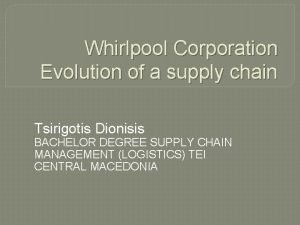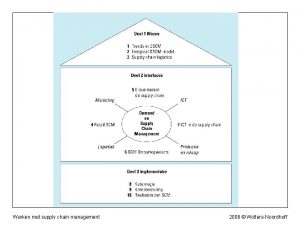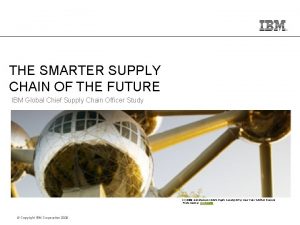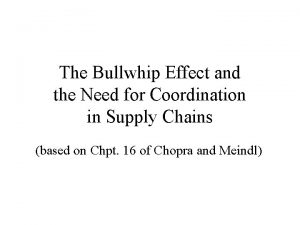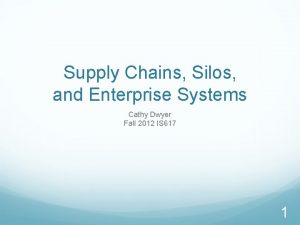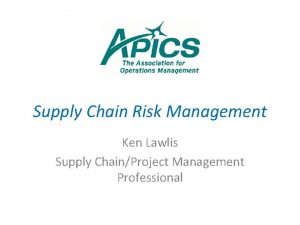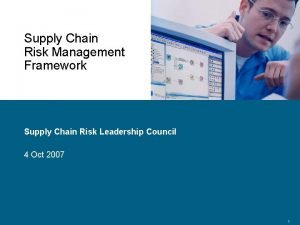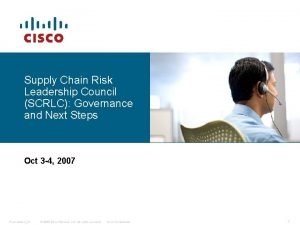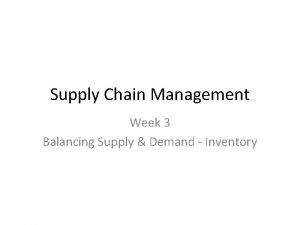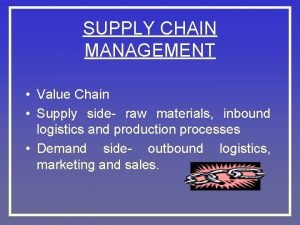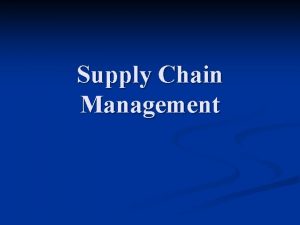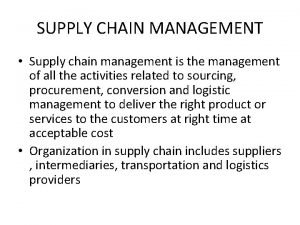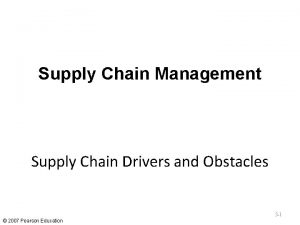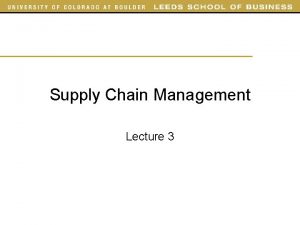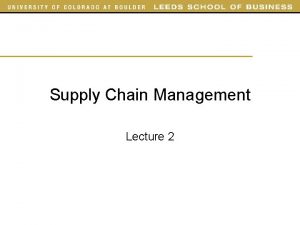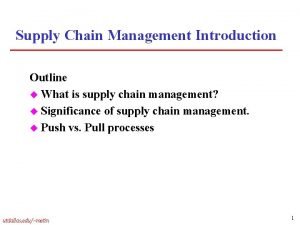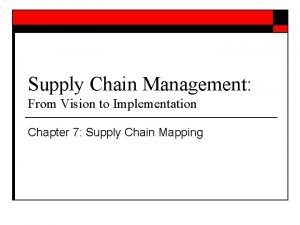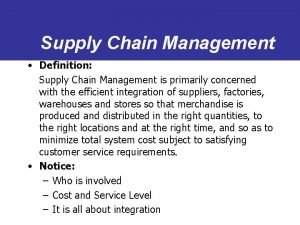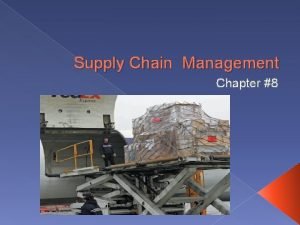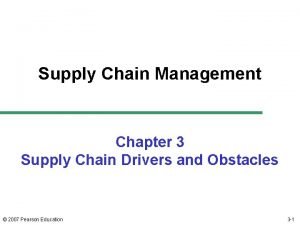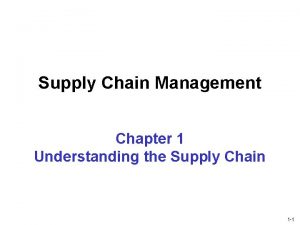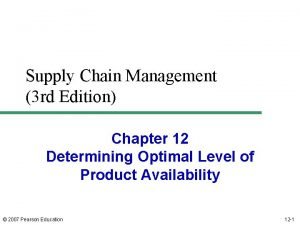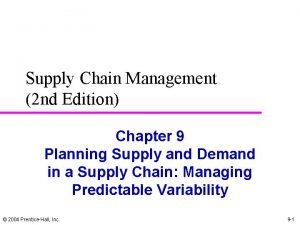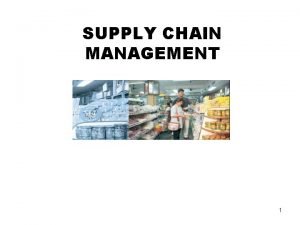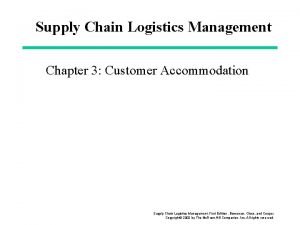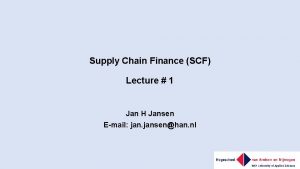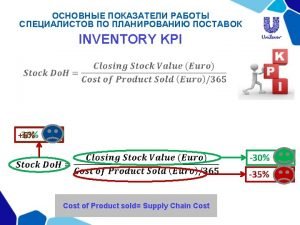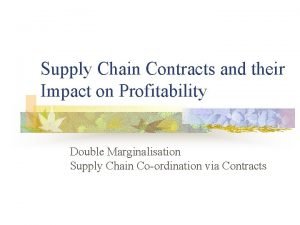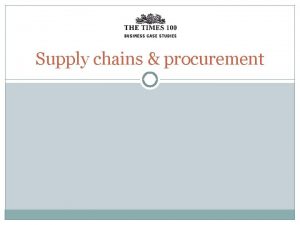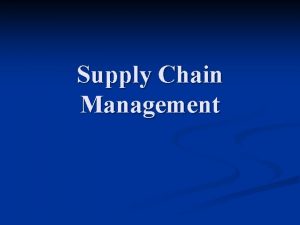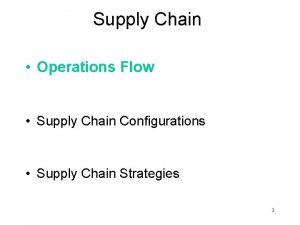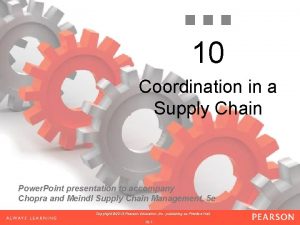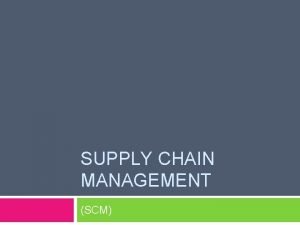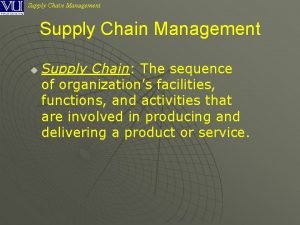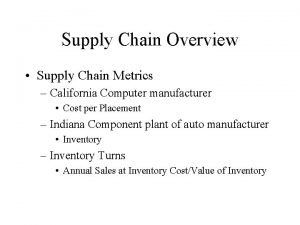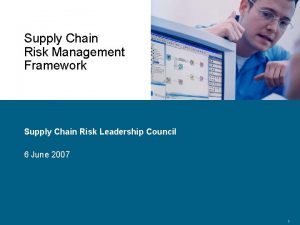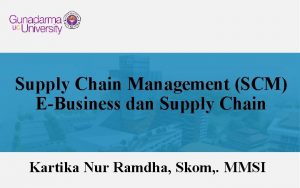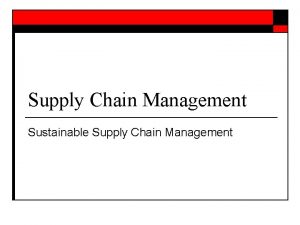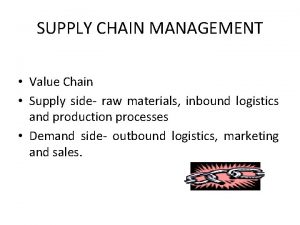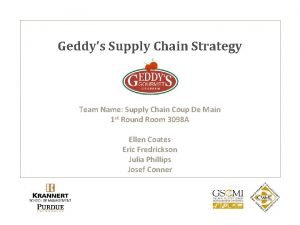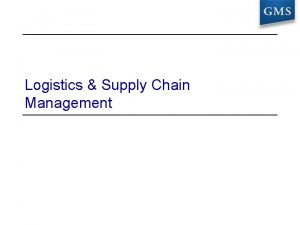10 Coordination in a Supply Chain Power Point






![The Effect on Performance of Lack of Coordination u Manufacturing cost (increases) [excess capacity] The Effect on Performance of Lack of Coordination u Manufacturing cost (increases) [excess capacity]](https://slidetodoc.com/presentation_image/2253790117f52e0a798834f464f7f57e/image-7.jpg)



































- Slides: 42

10 Coordination in a Supply Chain Power. Point presentation to accompany Chopra and Meindl Supply Chain Management, 5 e Global Edition Copyright © 2013 Pearson Education. 10 -1 1 -1

Objectives u. Describe supply chain coordination, the bullwhip effect, and their impact on performance u. Identify obstacles to coordination in a supply chain u. Discuss managerial levers that help achieve coordination in a supply chain u. Describe actions that facilitate the building of strategic partnerships and trust within a supply chain u. Understand the different forms of collaborative planning, forecasting and replenishment possible in a supply chain Copyright © 2010 Pearson Education, Inc. Publishing as Prentice Hall. 17 -2

Lack of Supply Chain Coordination and the Bullwhip Effect u. Supply chain coordination – all stages in the supply chain take actions together (usually results in greater total supply chain profits) u. SC coordination requires that each stage take into account the effects of its actions on the other stages u. Lack of coordination results when: – Objectives of different stages conflict or – Information moving between stages is distorted u. Challenge: achieving co-ordination despite multiple owenership and product variety Copyright © 2010 Pearson Education, Inc. Publishing as Prentice Hall. 17 -3

Bullwhip Effect u. Fluctuations in orders increase as they move up the supply chain from retailers to wholesalers to manufacturers to suppliers u. Distorts demand information within the supply chain, where different stages have very different estimates of what demand looks like u. Results in a loss of supply chain coordination u. Examples: Proctor & Gamble (Pampers); HP (printers); Barilla (pasta) Copyright © 2010 Pearson Education, Inc. Publishing as Prentice Hall. 17 -4

Bullwhip Effect Copyright © 2010 Pearson Education, Inc. Publishing as Prentice Hall.

The Effect on Performance • Supply chain lacks coordination if each stage optimizes only its local objective • Reduces total profits • Performance measures include – Manufacturing cost – Inventory cost – Replenishment lead time – Transportation cost – Labor cost for shipping and receiving – Level of product availability – Relationships across the supply chain Copyright © 2013 Pearson Education. 10 -6
![The Effect on Performance of Lack of Coordination u Manufacturing cost increases excess capacity The Effect on Performance of Lack of Coordination u Manufacturing cost (increases) [excess capacity]](https://slidetodoc.com/presentation_image/2253790117f52e0a798834f464f7f57e/image-7.jpg)
The Effect on Performance of Lack of Coordination u Manufacturing cost (increases) [excess capacity] u Inventory cost (increases) [increased safety stock] u Replenishment lead time (increases) u Transportation cost (increases) [expediting, spot prices] u Labor cost for shipping and receiving (increases) u Level of product availability (decreases) u Relationships across the supply chain (worsens) [blame and mistrusts] u Profitability (decreases) The bullwhip effect reduces supply chain profitability by making it more expensive to provide a given level of product availability Copyright © 2010 Pearson Education, Inc. Publishing as Prentice Hall. 17 -7

Causes and Counter-measures of the Bullwhip Effect Copyright © 2010 Pearson Education, Inc. Publishing as Prentice Hall.

Obstacles to Coordination in a Supply Chain u. Incentive Obstacles u. Information Processing Obstacles u. Operational Obstacles u. Pricing Obstacles u. Behavioral Obstacles Copyright © 2010 Pearson Education, Inc. Publishing as Prentice Hall. 9

Incentive Obstacles u When incentives offered to different stages or participants in a supply chain lead to actions that increase variability and reduce total supply chain profits – misalignment of total supply chain objectives and individual objectives u Local optimization within functions or stages of a supply chain – Double marginalisation – Localised objective (e. g. bulk transportation high inventory) u Sales force incentives – End-of-period “sell-in” spike to distributors; – no impact on “sell-through” to customers bullwhip effect! Copyright © 2010 Pearson Education, Inc. Publishing as Prentice Hall. 17 -10

Information Processing Obstacles u. When demand information is distorted as it moves between different stages of the supply chain, leading to increased variability in orders within the supply chain u. Forecasting based on orders, not customer demand – Forecasting demand based on orders magnifies demand fluctuations moving up the supply chain from retailer to manufacturer (e. g. beer game) u. Lack of information sharing – Mis-interpretation of fluctuations in demand Copyright © 2010 Pearson Education, Inc. Publishing as Prentice Hall. 17 -11

Operational Obstacles • Occur when placing and filling orders • • • lead to an increase in variability Ordering in large lots (much larger than according to demand) Large replenishment lead times Rationing and shortage gaming Copyright © 2013 Pearson Education. 10 -12

Operational Obstacles Figure 10 -2 Copyright © 2013 Pearson Education. 10 -13

Operational Obstacles u. Large replenishment lead times u. Rationing and shortage gaming (common in the computer industry because of periodic cycles of component shortages and surpluses) Copyright © 2010 Pearson Education, Inc. Publishing as Prentice Hall. 17 -14

Pricing Obstacles u. When pricing policies for a product lead to an increase in variability of orders placed u. Lot-size based quantity decisions u. Price fluctuations Copyright © 2010 Pearson Education, Inc. Publishing as Prentice Hall.

Pricing Obstacles Figure 10 -3 Copyright © 2010 Pearson Education, Inc. Publishing as Prentice Hall.

Behavioral Obstacles u Problems in learning, often related to communication in the supply chain and how the supply chain is structured u Each stage of the supply chain views its actions locally and is unable to see the impact of its actions on other stages u Different stages react to the current local situation rather than trying to identify the root causes u Based on local analysis, different stages blame each other for the fluctuations, with successive stages becoming enemies rather than partners u No stage learns from its actions over time because the most significant consequences of the actions of any one stage occur elsewhere, resulting in a vicious cycle of actions and blame u Lack of trust results in opportunism, duplication of effort, and lack of information sharing …at the expense of overall supply chain performance Copyright © 2010 Pearson Education, Inc. Publishing as Prentice Hall. 17 -17

Managerial Levers to Achieve Coordination u. Aligning Goals and Incentives u. Improving Information Accuracy u. Improving Operational Performance u. Designing Pricing Strategies to Stabilize Orders u. Building Strategic Partnerships and Trust Copyright © 2010 Pearson Education, Inc. Publishing as Prentice Hall. 17 -18

Aligning Goals and Incentives Aligning incentives and sharing risks grow total supply-chain surplus, hence grow profit share for each supply-chain member (win-win scenario) u. Align incentives so that each participant has an incentive to do the things that will maximize total supply chain profits u. Sharing risks (e. g. buyback contracts) u. Align incentives across functions u. Pricing for coordination u. Alter sales force incentives from sell-in (to the retailer) to sell-through (by the retailer) Copyright © 2010 Pearson Education, Inc. Publishing as Prentice Hall. 17 -19

Improving Information Accuracy u. Sharing point of sale data, inventory info, etc. u. Collaborative forecasting and planning – e. g. manufacturer need to know retailer’s promotion plans u. Single stage control of replenishment – Continuous replenishment programs (CRP) – Vendor managed inventory (VMI) Copyright © 2010 Pearson Education, Inc. Publishing as Prentice Hall. 17 -20

Improving Operational Performance u Reducing replenishment lead time – Reduces uncertainty and increase accuracy in demand forecasts (e. g. so allows multiple replenishment orders in the selling season) – Strategies to reduce lead time: » EDI useful to reduce “paperwork” in order-processing » Flexible manufacturing (reduce batch setup times) » Cross-docking (speeding transport) u Reducing lot sizes (e. g. reduced ordering/setup costs) – – Computer-assisted ordering, B 2 B exchanges Shipping in TL sizes by combining LTL shipments across products and suppliers Technology and other methods to simplify receiving Changing customer ordering behavior (e. g. periodic orders at beginning of month) u Rationing based on past sales and sharing information to limit gaming – “Turn-and-earn”; no incentive to inflate orders – Information sharing (pre-order, e. g. moon-cakes) Copyright © 2010 Pearson Education, Inc. Publishing as Prentice Hall. 17 -21

Designing Pricing Strategies to Stabilize Orders u. Encouraging retailers to order in smaller lots and reduce forward buying u. Moving from lot size-based to volume-based quantity discounts (consider total purchases over a specified time period) u. Stabilizing pricing – Eliminate promotions (everyday low pricing, EDLP) – Limit quantity purchased during a promotion – Tie promotion payments to sell-through rather than amount purchased u. Building strategic partnerships and trust – easier to implement these approaches if there is trust Copyright © 2010 Pearson Education, Inc. Publishing as Prentice Hall. 17 -22

Building Strategic Partnerships and Trust in a Supply Chain Each party is interested in the others’ welfare and will not act without considering impact on others. u Trust-based relationship – Dependability – Leap of faith u Cooperation and trust work because: – Alignment of incentives and goals – Actions to achieve coordination are easier to implement – Supply chain productivity improves by reducing duplication or allocation of effort in appropriate stage – Greater information sharing results » No quality/quantity checking upon receiving orders if suppliers shares quality control charts Copyright © 2010 Pearson Education, Inc. Publishing as Prentice Hall. 17 -23

Trust in the Supply Chain u. Historically, supply chain relationships are based on power or trust u. Disadvantages of power-based relationship: – Results in one stage maximizing profits, often at the expense of other stages – Can hurt a company when balance of power changes – Less powerful stages have sought ways to resist Copyright © 2010 Pearson Education, Inc. Publishing as Prentice Hall. 17 -24

Building Trust into a Supply Chain Relationship How to initiate and sustain a trust relationship? u Deterrence-based view – Use formal contracts – Parties behave in trusting manner out of self-interest u Process-based view – Trust and cooperation are built up over time as a result of a series of interactions – Positive interactions strengthen the belief in cooperation of other party u Neither view holds exclusively in all situations – Contracts cannot cover every contingency – “Word (teeth)” good as gold … but maybe still need some agreed-upon ground rules Copyright © 2010 Pearson Education, Inc. Publishing as Prentice Hall. 17 -25

Building Trust into a Supply Chain Relationship u Initially more reliance on deterrence-based view, then evolves to a process-based view u Co-identification: ideal goal u Two phases to a supply chain relationship – Design phase – Management phase u Designing a Trusting Relationship – – Assessing the value of the relationship and its contributions Identifying operational roles and decision rights for each party Creating effective contracts Designing effective conflict resolution mechanisms Copyright © 2010 Pearson Education, Inc. Publishing as Prentice Hall. 17 -26

Assessing the Value of the Relationship and its Contributions u. Identify the mutual benefit provided u. Identify the criteria used to evaluate the relationship (equality and fairness important) u. Important to share benefits equitably u. Clarify contribution of each party and the benefits each party will receive u. Need mechanisms for partners to monitor and adjust contributions and allocation of benefits Copyright © 2010 Pearson Education, Inc. Publishing as Prentice Hall. 17 -27

Identifying Operational Roles and Decision Rights for Each Party u. Recognize interdependence between parties – Sequential interdependence: activities of one partner precede the other – Reciprocal interdependence: the parties come together, exchange information and inputs in both directions u. Sequential interdependence is the traditional supply chain form u. Reciprocal interdependence is more difficult but can result in more benefits Copyright © 2010 Pearson Education, Inc. Publishing as Prentice Hall. 17 -28

Organization’s Dependence Effects of Interdependence on Supply Chain Relationships High Low Partner Relatively Powerful Low Level of Interdependence Low High Level of Interdependence Effective Relationship Organization Relatively Powerful High Partner’s Dependence Copyright © 2010 Pearson Education, Inc. Publishing as Prentice Hall. 17 -29

Creating Effective Contracts u. Create contracts that encourage negotiation when unplanned contingencies arise u. It is impossible to define and plan for every possible occurrence u. Informal relationships and agreements can fill in the “gaps” in contracts u. Informal arrangements may eventually be formalized in later contracts Copyright © 2010 Pearson Education, Inc. Publishing as Prentice Hall. 17 -30

Designing Effective Conflict Resolution Mechanisms u. Initial formal specification of rules and guidelines for procedures and transactions u. Sharing information over time engenders trust and smooth relationships u. Regular, frequent meetings to promote communication u. Conflict resolution and cultural perspectives – USA: Courts or other intermediaries – Asia: negotiated settlements Copyright © 2010 Pearson Education, Inc. Publishing as Prentice Hall. 17 -31

Managing Supply Chain Relationships for Cooperation and Trust u Effective management of a relationship is important for its success u Top management is often involved in the design but not management of a relationship u Perceptions of reduced benefits or opportunistic actions can significantly impair a supply chain partnership u Relationship success factors: – Flexibility, trust and commitment of top management – Good organisational arrangements (e. g. for information sharing and conflict resolution) – “Visibility”: helps identify defective process and reduces opportunistic exploitation by one party – The more fairly the dominant party treats the weaker, the stronger the relationship Copyright © 2010 Pearson Education, Inc. Publishing as Prentice Hall. 17 -32

Continuous Replenishment and Vendor-Managed Inventories u A single point of replenishment u CRP – wholesaler or manufacturer replenishes based on POS data u VMI – manufacturer or supplier is responsible for all decisions regarding inventory u VMI requires retailer to share sales information with suppliers improved forecasts and better matching of supply to demand u Impact of Substitution – Some retailers may have VMI arrangements with competing suppliers (e. g. P&G, Lever Brothers) leading to overstock. Copyright © 2010 Pearson Education, Inc. Publishing as Prentice Hall. 33

Collaborative Planning, Forecasting, and Replenishment (CPFR) A business practice that combines intelligence of multiple partners in the planning and fulfilment of customer demand. u Sellers and buyers in a supply chain may collaborate along any or all of the following: – – Strategy and planning Demand supply management Execution Analysis u Organizational requirements – Procedures for exception handling – Cross-functional customer-specific teams u Risks and Hurdles for a CPFR implementation – Information leakage and misuse – “forced” technology upgrade – Merging of cultures (e. g. MTR/KCR) Copyright © 2010 Pearson Education, Inc. Publishing as Prentice Hall. 17 -34

Common CPFR Scenarios Where Applied in Supply Chain Industries Where Applied Retail event collaboration Highly promoted channels or categories All industries other than those that practice EDLP DC replenishment collaboration Retail DC or distributor DC Drugstores, hardware, grocery Store replenishment collaboration Direct store delivery or retail DC-to-store delivery Mass merchants, club stores Collaborative assortment planning Apparel and seasonal goods Department stores, specialty retail CPFR Scenario Table 10 -2 Copyright © 2010 Pearson Education, Inc. Publishing as Prentice Hall.

Collaborative Planning, Forecasting, and Replenishment (CPFR) u. Store replenishment collaboration u. Collaborative assortment planning u. Organizational and technology requirements for successful CPFR u. Risks and hurdles for a CPFR implementation Copyright © 2010 Pearson Education, Inc. Publishing as Prentice Hall.

Collaborative Planning, Forecasting, and Replenishment (CPFR) Figure 10 -4 Copyright © 2010 Pearson Education, Inc. Publishing as Prentice Hall.

Collaborative Planning, Forecasting, and Replenishment (CPFR) • Sellers and buyers in a supply chain may collaborate along any or all of the following • • 1. 2. 3. 4. Strategy and planning Demand supply management Execution Analysis Retail event collaboration DC replenishment collaboration Copyright © 2013 Pearson Education. 10 -38

Collaborative Planning, Forecasting, and Replenishment (CPFR) A business practice that combines intelligence of multiple partners in the planning and fulfilment of customer demand. u Sellers and buyers in a supply chain may collaborate along any or all of the following: – – Strategy and planning Demand supply management Execution Analysis u Organizational requirements – Procedures for exception handling – Cross-functional customer-specific teams u Risks and Hurdles for a CPFR implementation – Information leakage and misuse – “forced” technology upgrade – Merging of cultures (e. g. MTR/KCR) Copyright © 2010 Pearson Education, Inc. Publishing as Prentice Hall. 17 -39

The Role of IT in Coordination u Enablement of coordination the ultimate goal u IT’s role: – Information availability – Use of information available to make decisions – Facilitate sharing of forecasts and historical information, and enable revisions – Enterprise systems that record all the supply-chain transactions u Pitfalls/Challenges: – Systems integration – Co-ordinating operational procedures – trust Copyright © 2010 Pearson Education, Inc. Publishing as Prentice Hall. 17 -40

Achieving Coordination in Practice u. Quantify the bullwhip effect u. Get top management commitment for coordination u. Devote resources to coordination u. Focus on communication with other stages u. Try to achieve coordination in the entire supply chain network u. Use technology to improve connectivity in the supply chain u. Share the benefits of coordination equitably Copyright © 2010 Pearson Education, Inc. Publishing as Prentice Hall. 17 -41

Summary of Learning Objectives u. What are supply chain coordination and the bullwhip effect, and what are their effects on supply chain performance? u. What are obstacles to coordination in the supply chain? u. What are the managerial levers that help achieve coordination in the supply chain? u. What are actions that facilitate the building of strategic partnerships and trust in the supply chain? u. What are the different forms of CPFR available in a supply chain? Copyright © 2010 Pearson Education, Inc. Publishing as Prentice Hall. 17 -42
 15 isomers of mabcdef
15 isomers of mabcdef Matching supply with demand
Matching supply with demand Value chain and supply chain difference
Value chain and supply chain difference Food chain food chain food chain
Food chain food chain food chain Flex28024a
Flex28024a Real power and reactive power
Real power and reactive power Power bi power point
Power bi power point Point point power
Point point power Chapter 5 section 1 supply and the law of supply
Chapter 5 section 1 supply and the law of supply Ano ang ratio ng elastisidad
Ano ang ratio ng elastisidad Whirlpool corporation evolution of a supply chain
Whirlpool corporation evolution of a supply chain Werken met supply chain management noordhoff
Werken met supply chain management noordhoff Viewpoint for project collaboration
Viewpoint for project collaboration Enterprise resource planning ppt
Enterprise resource planning ppt Ibm smart supply chain
Ibm smart supply chain Pipeline in supply chain
Pipeline in supply chain Behavioral obstacles in supply chain
Behavioral obstacles in supply chain Silos in supply chain
Silos in supply chain Supply chain risk register
Supply chain risk register Supply chain risk management framework
Supply chain risk management framework Supply chain risk management framework
Supply chain risk management framework Cisco supply chain risk management
Cisco supply chain risk management Supply chain leadership council
Supply chain leadership council Eoq supply chain
Eoq supply chain Value chain structure
Value chain structure What is the correct sequence in supply chain
What is the correct sequence in supply chain Supply chain it framework
Supply chain it framework Framework for structuring drivers
Framework for structuring drivers Netflix supply chain
Netflix supply chain Collaborative supply chain
Collaborative supply chain Replenishment cycle in supply chain
Replenishment cycle in supply chain Supply chain management process mapping
Supply chain management process mapping Intraoperation scope
Intraoperation scope Order promising module of supply chain management
Order promising module of supply chain management Drivers of supply chain management
Drivers of supply chain management Push pull view of supply chain
Push pull view of supply chain Tailored sourcing supply chain
Tailored sourcing supply chain Predictable variability is
Predictable variability is Replenishment cycle in supply chain
Replenishment cycle in supply chain Customer accommodation definition
Customer accommodation definition Polyself.xyz paradigm
Polyself.xyz paradigm Cost structure sample
Cost structure sample Buy back contract supply chain example
Buy back contract supply chain example










